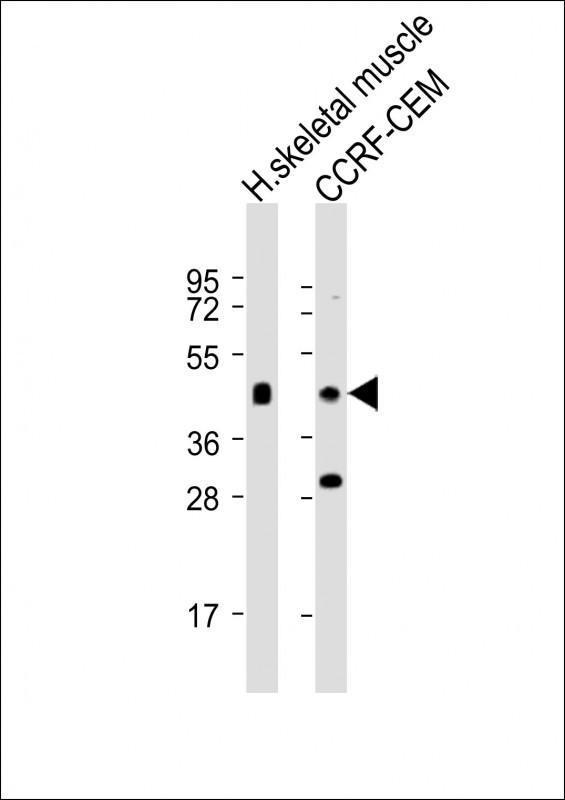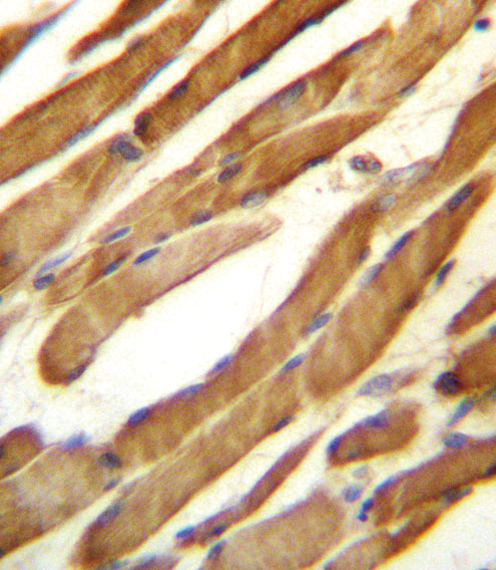SLC16A10 Antibody (C-term)
Affinity Purified Rabbit Polyclonal Antibody (Pab)
- SPECIFICATION
- CITATIONS
- PROTOCOLS
- BACKGROUND

Application
| WB, FC, IHC-P, E |
|---|---|
| Primary Accession | Q8TF71 |
| Other Accession | NP_061063.2 |
| Reactivity | Human |
| Host | Rabbit |
| Clonality | Polyclonal |
| Isotype | Rabbit IgG |
| Calculated MW | 55493 Da |
| Antigen Region | 301-329 aa |
| Gene ID | 117247 |
|---|---|
| Other Names | Monocarboxylate transporter 10, MCT 10, Aromatic amino acid transporter 1, Solute carrier family 16 member 10, T-type amino acid transporter 1, SLC16A10, MCT10, TAT1 |
| Target/Specificity | This SLC16A10 antibody is generated from rabbits immunized with a KLH conjugated synthetic peptide between 301-329 amino acids from the C-terminal region of human SLC16A10. |
| Dilution | WB~~1:2000 FC~~1:10~50 IHC-P~~1:25 E~~Use at an assay dependent concentration. |
| Format | Purified polyclonal antibody supplied in PBS with 0.09% (W/V) sodium azide. This antibody is purified through a protein A column, followed by peptide affinity purification. |
| Storage | Maintain refrigerated at 2-8°C for up to 2 weeks. For long term storage store at -20°C in small aliquots to prevent freeze-thaw cycles. |
| Precautions | SLC16A10 Antibody (C-term) is for research use only and not for use in diagnostic or therapeutic procedures. |
| Name | SLC16A10 |
|---|---|
| Synonyms | MCT10, TAT1 {ECO:0000303|PubMed:11827462 |
| Function | Sodium- and proton-independent thyroid hormones and aromatic acids transporter (PubMed:11827462, PubMed:18337592, PubMed:28754537). Mediates both uptake and efflux of 3,5,3'-triiodothyronine (T3) and 3,5,3',5'-tetraiodothyronine (T4) with high affinity, suggesting a role in the homeostasis of thyroid hormone levels (PubMed:18337592). Responsible for low affinity bidirectional transport of the aromatic amino acids, such as phenylalanine, tyrosine, tryptophan and L-3,4- dihydroxyphenylalanine (L-dopa) (PubMed:11827462, PubMed:28754537). Plays an important role in homeostasis of aromatic amino acids (By similarity). |
| Cellular Location | Cell membrane; Multi-pass membrane protein. Basolateral cell membrane {ECO:0000250|UniProtKB:Q91Y77}; Multi-pass membrane protein |
| Tissue Location | Strongly expressed in kidney and skeletal muscle and at lower level in placenta and heart |

Thousands of laboratories across the world have published research that depended on the performance of antibodies from Abcepta to advance their research. Check out links to articles that cite our products in major peer-reviewed journals, organized by research category.
info@abcepta.com, and receive a free "I Love Antibodies" mug.
Provided below are standard protocols that you may find useful for product applications.
Background
SLC16A10 is a member of a family of plasma membrane amino acid transporters that mediate the Na(+)-independent transport of aromatic amino acids across the plasma membrane.
References
Loubiere, L.S., et al. Placenta 31(4):295-304(2010)
Friesema, E.C., et al. Mol. Endocrinol. 22(6):1357-1369(2008)
Broer, S. Physiol. Rev. 88(1):249-286(2008)
Park, S.Y., et al. Arch. Pharm. Res. 28(4):421-432(2005)
Halestrap, A.P., et al. Pflugers Arch. 447(5):619-628(2004)
If you have used an Abcepta product and would like to share how it has performed, please click on the "Submit Review" button and provide the requested information. Our staff will examine and post your review and contact you if needed.
If you have any additional inquiries please email technical services at tech@abcepta.com.













 Foundational characteristics of cancer include proliferation, angiogenesis, migration, evasion of apoptosis, and cellular immortality. Find key markers for these cellular processes and antibodies to detect them.
Foundational characteristics of cancer include proliferation, angiogenesis, migration, evasion of apoptosis, and cellular immortality. Find key markers for these cellular processes and antibodies to detect them. The SUMOplot™ Analysis Program predicts and scores sumoylation sites in your protein. SUMOylation is a post-translational modification involved in various cellular processes, such as nuclear-cytosolic transport, transcriptional regulation, apoptosis, protein stability, response to stress, and progression through the cell cycle.
The SUMOplot™ Analysis Program predicts and scores sumoylation sites in your protein. SUMOylation is a post-translational modification involved in various cellular processes, such as nuclear-cytosolic transport, transcriptional regulation, apoptosis, protein stability, response to stress, and progression through the cell cycle. The Autophagy Receptor Motif Plotter predicts and scores autophagy receptor binding sites in your protein. Identifying proteins connected to this pathway is critical to understanding the role of autophagy in physiological as well as pathological processes such as development, differentiation, neurodegenerative diseases, stress, infection, and cancer.
The Autophagy Receptor Motif Plotter predicts and scores autophagy receptor binding sites in your protein. Identifying proteins connected to this pathway is critical to understanding the role of autophagy in physiological as well as pathological processes such as development, differentiation, neurodegenerative diseases, stress, infection, and cancer.






